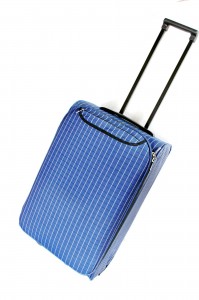On one hand, I love researching, planning and (of course) going on trips. On the other hand, packing has always been the bane of my existence. For years, not matter how far in advance I started packing for a trip, I always found it to be a stressful and aggravating experience for me: What to bring? What to leave behind? How many of these do I really need? A few times I packed so much that I ended up having to pay extra baggage fees because my suitcase was overweight. And then there were the trips where I ran out of clothes within three days (not because I had brought too few items, but because I had brought the wrong things for the type of trip I was on).
To streamline my packing process (and save myself time, hassle and money in the process), I developed a series of guidelines. Of course, you can’t completely plan for any eventuality, but these general guidelines have served me well over the years. I hope they do the same for you.
When it comes to choosing a suitcase, smaller is better. Especially if you’re going on a trip where you will be moving from place to place quite frequently, you’ll appreciate having a smaller bag (preferably one with wheels to save your back from having to lug it everywhere, or a large backpack if that is easier for you). Selecting your small or medium-sized suitcase before you begin choosing what to bring will force you to streamline your packing. Of course, if your bag is small enough (and you adhere to current air safety guidelines), you could avoid having to check it all together, which would save you time at the airport and once you reach your destination.
Consider the climate you are going to. Do a quick forecast check to get a feel for what the weather will be like during your trip (keeping in mind, of course, that weather predictions aren’t always accurate). If you’re going to a place that is mostly sunny and warm during the month you’ll be visiting, then you can feel confident packing mostly warm weather clothes with a light sweater and a rain jacket (just in case).
Keep in mind what types of activities you will be doing. It’s important to pack clothes that are appropriate for the types of things you will be doing on your trip. A bike trip across France will necessitate a different wardrobe than an art tour of Florence. However, there is one piece of advice that holds true for most destinations: pack comfortable walking shoes. I always end up walking (or sprinting to catch public transportation) more than I ever expected while on vacation. Pack at least 2 pair of shoes that will be kind to your hardworking feet.
Consider cultural norms. It’s important to keep in mind the customs of the place you’ll be visiting (to avoid sticking out as the “ugly American”). For example, if you will be visiting places of worship, it is typically customary to wear long pants or a skirt and to keep your shoulders covered. If you are planning to eat in fancy restaurants, keep in mind that there will most likely be a dress code and plan ahead.
Mix and match, re-use, re-wear. As you think about what clothes you’d like to bring on your trip, choose a color scheme and stick with it. That way you can mix and match different elements. While you may want to bring a different top for each day, most pants and skirts can be re-worn several times throughout a trip.
Assess the laundry situation. Contact the hotel / hostel / lodging where you will be staying to see if there will be the opportunity to do laundry on-site or at a nearby Laundromat. While you don’t want to spend too much time on your trip doing laundry, taking an hour or two to wash your clothes mid-trip will save you from having to pack double.
Do a cost-hassle analysis. Are there certain toiletries, etc. that you could buy on-site instead of bringing with you? Do you really need to bring that case of granola bars, or can you make do with snacks you buy at your destination. Think about the “negotiable” items on your list and whether or not you could buy them (at a reasonable price) once you arrive.
Make a list, check it twice. To avoid forgetting any essentials (and being sorely disappointed when you discover they are missing), make a packing list and check off items as you put them in your bag.
Give yourself time. Resist the urge to procrastinate and begin packing at least several days before you leave. This will give you extra time to double check your bag to make sure you’ve included everything you will need.
Happy packing!
